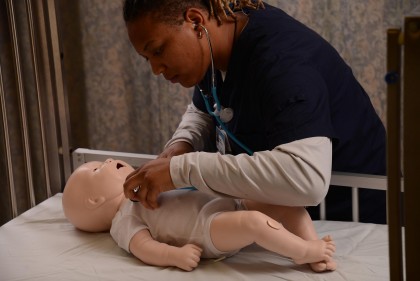Infant Patient Simulator Baby Sim
Manufactured By :
CAE Healthcare, USA 
Available Options :
This product is not available in stock.
Tiny humans depend on us in big ways. That's why CAE Healthcare skipped no details in developing its smallest member of the patient simulation family. CAE BabySIM is an infant-sized, high-fidelity simulator that is powered by advanced physiology for practicing critical care and trauma care. BabySIM delivers critical training features designed to immerse learners in a realistic clinical environment.
Neurological
• Tri-state pupils and blinking eyes
• Automatic changes in blinking based on inadequate respiratory and cardiovascular conditions
• Palpable anterior fontanel
• Bulging fontanel capability to simulate increased intracranial pressure
Airway
• Realistic upper airway represents oropharynx, nasopharynx and larynx
• Intubation: orotracheal, nasotracheal, ET tubes, right mainstem
• Combitube and other airway adjunct placement
• Bag-valve-mask ventilation
• Needle cricothyrotomy
Breathing
• Seesaw breathing
• Bilateral chest rise and fall
• Measures the presence or absence of carbon dioxide exhalation
• Spontaneous breathing
• Unilateral chest tube insertion with fluid output
• Unilateral needle decompression
Cardiac
• Defibrillation and cardioversion using live defibrillators, energy is automatically quantified and logged
• Pacing (use of hands-free pads), current is automatically quantified and logged
• 3-lead dynamic ECG display
CPR
• Correct hand placement, depth, and rate of compressions are reflected in physiological feedback rather than virtual target on instructor’s workstation
• Adequate chest compressions result in simulated circulation, cardiac output, central and peripheral blood pressures, carbon dioxide return
Circulation
• Blood pressure measurement by auscultation and palpation
• Bilateral brachial and femoral pulses
Urological
• Urine output
• Interchangeable genitalia
Vascular Access
• IV access supported via left femoral catheter
• IO site on anterior tibia of right leg
Pharmacology System
• Pharmacology system models automatically calculate the pharmacokinetics and
pharmacodynamics for six intravenous and inhaled medications
• All patient responses to drugs are automatic, dose dependent and follow appropriate time course
Trauma
• Secretions from eyes, ears and mouth
Sounds
• Crying/Cooing
• Pre-recorded sounds and voices
• Customized sounds and voices via the provided wireless microphone


